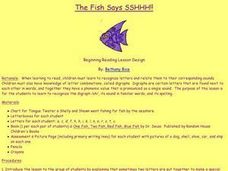Curated OER
The Cat Ate My Apple
Students recognize the phoneme for the short vowel a in written and spoken language. Through a variety of activities, they discriminate the short vowel /a/ from other phonemes. Students associate the phoneme with its letter...
Curated OER
Lizzy the Icky Sticky Lizard
First graders recognize the short vowel i in written and spoken language. Through listening activities, they discriminate the vowel sound /i/ from other phonemes. Students associate the phoneme with its letter representation and identify...
Curated OER
It's O-o-o-obvious That You're Sick
Students experience the phonemes and map spellings of the short vowel /o/ sounds in spoken words. They practice matching letters to phonemes to identify the /o/ representations and letter symbols in words. Students work with the Dr....
Curated OER
It's Icky Icky Sticky
Learners recognize the short vowel i in written and spoken language. Through listening and matching activities, they discriminate the vowel sound /i/ from other phonemes. Students identify the phoneme and letter in pseudo words they decode.
Curated OER
Up, Up and Away
Students recognize the short vowel u in written and spoken language. Through matching and listening activities, they discriminate the vowel sound /u/ from other phonemes. Students identify the phoneme and letter in words and pictures.
Curated OER
It's Icky Sticky
Students recognize the short vowel a in written and spoken language. Through matching and listening activities, they discriminate the vowel sound /a/ from other phonemes. Students identify the phoneme and letter in pseudo words they decode.
Curated OER
Yummy in My Tummy
Students explore phonemes in spoken words. They discuss the correspondence u=/u/. Students identify a meaningful representation for the phoneme and practice identifying /u/ in both written and spoken words. Students learn a tongue...
Curated OER
What Did You Say?
Learners recognize the short vowel E in written and spoken language. Through matching activities, they discriminate the short vowel /e/ from other phonemes. Students associate the phoneme with its letter representation and read pseudo...
Curated OER
Say aahhh....said the doctor
Students recognize the short vowel O in written and spoken language. Through matching activities, they discriminate the short vowel /o/ from other vowel sounds. Students associate the phoneme with its letter representation and identify...
Curated OER
When is Ed Fed?
Students recognize the short vowel "E" in written and spoken language. Through listening and writing activities, they discriminate the short vowel /e/ from other vowel sounds. Students associate the phoneme with its letter representation...
Curated OER
Shirley's Sea Shells
First graders identify the digraph /sh/ in written and spoken language. After a brief discussion of the independent and combined sounds of the phonemes /s/ and /h/ students practice identifying initial and final placement of the new...
Curated OER
The Fish Says SSHHH!!
First graders identify the digraph /sh/ in written and spoken language. After a brief discussion the independent and combined sounds of the phonemes /s/ and /h/ students practice identifying initial and final placement of the new digraph...
Curated OER
Ugh!
First graders focus on the phoneme /u/. They make the sound and say "Ugh" and pronounce other words that contain the /u/ sound such as tub. They then repeat a tongue twister featuring the /u/ sound breaking the sound off each word and...
Curated OER
Bubbly Bs and Dull Ds
Students practice discerning between the letters D and B. Through hands on activities, they recognize the difference between the commonly confused letters B and D. They practice writing both letters and correcting common mistakes and...















